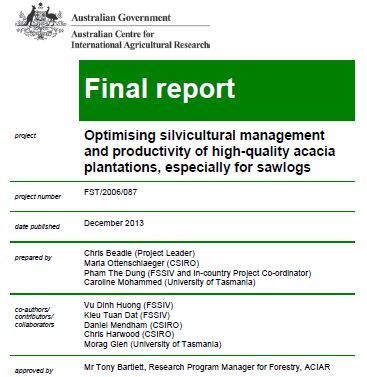Executive summary

Vietnam imports 80% of its wood supply to service a growing export-focused furniture industry. The small-holder sector manages approximately half the total area of its plantation forests. A pre-project financial analysis had shown that there may be significant economic advantages for typical small-holders of sawlog over pulpwood production. We investigated the suitability of silvicultural systems that optimise the production of sawlogs from the most commonly planted species, Acacia hybrid, by exploiting its very high early growth rates and minimizing the length of rotation required to attain a commercial log size. Short rotations are an economic imperative for farmers who need the cash flow and income sooner rather than later. A key objective was to develop tools to support improved management of these plantations in the context of site, silvicultural inputs and sustainable management.
A series of trials that incorporated a common silvicultural approach to site preparation, planting, weed control, pruning and fertiliser application at planting showed that growth rates were consistently higher in southern than central and northern Vietnam which have a longer dry season and a colder winter, respectively. An important finding was that patterns of growth appeared distinct between the south and other parts of Vietnam such that the length of rotation to final harvest will be least in the south where diameter growth rates were 7.6-10.4 cm to age 2 years; in Central Vietnam it was 7.3 cm, and in the north 6.3-6.5 m to age 2 years.
There was a very strong response of tree diameter to thinning at either age two or age three years to 600 or 450 stems/ha which became statistically significant as early as six months after thinning. This response increased with intensity of thinning and showed that inter-tree competition for resources is very high in fast-growing Acacia hybrid stands established at conventional stockings between 1111 and 1667 trees per hectare such that individual tree growth rates and therefore saw-log values can be compromised as early as age two years; delayed thinning and low thinning intensities may also compromise individual tree growth. This rapid response to thinning was not related to the application of fertiliser at thinning at the southern sites but was at the northern sites. However there was no simple relationship between a measure of potential phosphorus supply and diameter growth at age two years across sites; the highest productivity sites were on soils that combined a high total nitrogen and organic carbon content. In the absence of factors that downgrade wood quality, the research found that with improved silviculture, including thinning, management for saw logs is financially more attractive than for pulpwood over a six-year rotation, a length commonly adopted for pulpwood.
Poor planting stock and high rates of fertiliser application can lead to the formation of poor form and lack of stem straightness and large branches. Pruning large branches led to the development of heart rot at southern sites which makes logs unacceptable for sawn timber. The very high growth rates which led to the formation of large crowns were associated with branch and on occasions stem breakage during severe storm events. Better choice of planting stock, timely and correct pruning techniques, and management of canopy size are therefore essential if these problems are to be minimised. Surveys and the experimental data suggest that in addition to heart-rot fungi there are other significant biotic agents that may impact on wood quality.
A package of extension materials was delivered to the National Agricultural and Forestry Extension Centre: (i) a Decision Support System (DSS) with look-up tables that can be used to evaluate site productivity; (ii) a template for Economic Analyses that allows comparative evaluation of financial returns from contrasting silvicultural systems, including for saw logs; and (iii) seven Technical Information Sheets giving advice on soils and the management of silvicultural inputs for saw-log production. The key audience for these materials is Extension Officers who service the small-holder sector at provincial and district levels.
Final report: Optimising silvicultural management and productivity of high-quality acacia plantations, especially for sawlogs
Page 6
Successful communication of the information gained from this project through the extension services should enable the transformation of a plantation resource from one that is primarily focused on low-value pulpwood to a high-value resource that can markedly reduce Vietnam’s reliance on imported timber. Extension personnel report that changing the silvicultural practices of growers in Vietnam is a challenge, particularly if improved outcomes depend on timely interventions of inputs like fertiliser, pruning and thinning. Producing trees of good form, an essential requirement for saw logs, also requires high quality seedlings or clones. The establishment of demonstration plantations that incorporate best practice at district level should be tested as a means of encouraging the adoption of the silvicultural approaches developed by this project for saw-log production in the small-holder sector.
Source: Forest Science Institute of South Vietnam (FSISV) Copy right © Australian Centre for International Agricultural Research (ACIAR) 2013
Latest news
- Project: "Research on improving the economic efficiency of plantation timber value chains, meeting legal timber requirements and sustainable forest management"
- Project: Commercial-scale yield trial and completion of planting techniques for newly recognized acacia hybrid cultivars (BV586, BV376, BB055, BV584, BV523, BV434, BV350)
- Project: Study on technology of producing hollow veneer-based composite used in construction and interior wooden furniture
- VFCS is published on the website of the Forestry Department, Ministry of Agriculture, Forestry and Fisheries of Japan
- Memorandum of Understanding signing ceremony on handing over new wood material samples from the Finnish Embassy to the VAFS for displaying
Oldest news
- List of new National germplasm and Technological advanced germplasm transfered to production during the period of 2006-2013
- Vietnam Journal of Forest Science Number 1-2014
- Project “Enhancement of production of Acacia and Eucalypt peeled and sliced veneer products in Vietnam and Australia”
- A new species od Adinandra jack. (Theaceae) from Vietnam
- IUFRO Acacia 2014 - "Sustaining the Future of Acacia Plantation Forestry" booklet






